Learn about fire sprinkler system sensors—flow switches, pressure switches, tamper switches, and more
When it comes to protecting life and property from fires, basically nothing beats an automatic fire sprinkler system—but only if it works, of course.
If a fire runs unchecked despite the presence of fire sprinklers, odds are the system was nonfunctional in some way. This can happen for different reasons, but the most common way to impair a fire sprinkler system is to close control valves. It’s why specific equipment is designed to ensure these valves remain open and systems operational.
In this article, we examine the role of supervisory switches, devices that deliver crucial knowledge about the state of a sprinkler system. We’ll especially highlight the importance of tamper switches, which send trouble signals when they detect valve closure.
Ensure your fire sprinkler system is up to code and remains ready. Install the proper supervisory switches, including flow switches, pressure switches, and tamper switches for both butterfly and post-indicator valves and OS&Y valves.
What is a supervisory switch?
Supervisory switches detect the status of a fire sprinkler system and relay that information to a central, proprietary, or remote monitoring center or sound a local alarm.
To properly maintain a fire sprinkler system, you need key information. For instance, you must know as soon as possible if someone closes the control valve or if a sprinkler head activates.
However, sprinkler systems have many elements beyond pipes, valves, and sprinkler heads. Different setups incorporate various components, such as dry valves or preaction valves in those types of systems, fire pumps, or water tanks. Facility managers must monitor each of these elements for status and functionality.
Thus, a wide variety of supervisory switches are used to keep an eye on sprinkler systems and answer questions like:
- Are the sprinklers discharging?
- Is the control valve open?
- Is the fire pump running?
- What is the air pressure in the dry system?
- What is the water level in the water tank?
The two most common kinds of supervisory switches found in most sprinkler systems are tamper switches to monitor the control valves and flow or pressure switches to detect when a sprinkler system flows water.
Tamper switches and valve supervision
According to the National Fire Protection Association (NFPA), the control valve is the most common point of failure in fire sprinkler systems. In cases where sprinklers failed to operate during a fire, 57% were due to the system being shut off.
Whether it was done during maintenance and forgotten, or someone did it maliciously, shutting the control valve removes the water supply and renders a sprinkler system inoperable.
For this reason, NFPA 13: Standard for the Installation of Sprinkler Systems has multiple rules to ensure that control valves stay open. These items boil down to two techniques: valves must be indicating, and they must be locked and/or supervised. Perhaps the best way to supervise a valve is with an electronic tamper switch.
Indicating valves
The most basic rule states that it should be simple to determine whether a valve is open or closed. In the language of NFPA 13 (2022 edition: 16.9.3.2), control valves must be “indicating.” This means the valve displays the position of the valve—open or closed—for quick viewing by building management, contractors, and first responders.
In above-ground valves, the orientation of a vane (as in a butterfly valve) or the position of a stem (as in an outside stem and yoke valve (OS&Y)) indicate whether a valve is open or closed. And any below-ground valves need indicating posts to show their open or closed status.
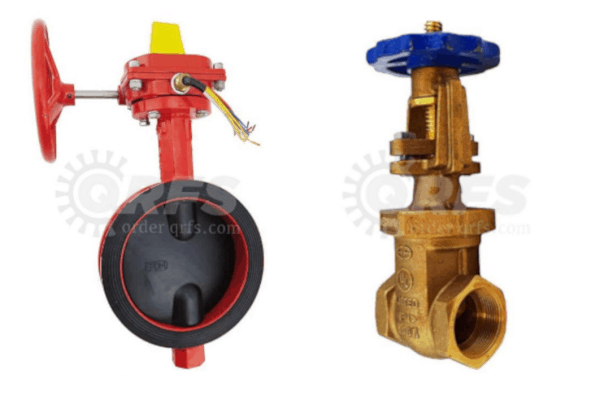
Supervision and tamper switches
NFPA 13 (16.9.3.3.1) requires additional layers of security in the form of supervision, which can take different approaches. Physical security can be a viable solution allowed by NFPA 13. Facilities managers may lock the valve in the correct position. Alternatively, they could use a fenced enclosure as long as the valve is inspected weekly and sealed in the open position.
The most sophisticated and effective form of supervision is electronic supervision with tamper switches. A tamper switch is a relatively simple piece of equipment consisting of:
- A tamper-proof housing for the circuitry
- A cable outlet to communicate with a fire alarm panel or monitoring system
- An actuating arm that interfaces with the valve
- Mounting hardware
When installed as a separate component, the tamper switch is placed into the valve’s body so that the actuating arm or lever interacts with the moving part of the valve. Closing the valve causes the arm to move, completing the circuit and triggering a trouble signal.
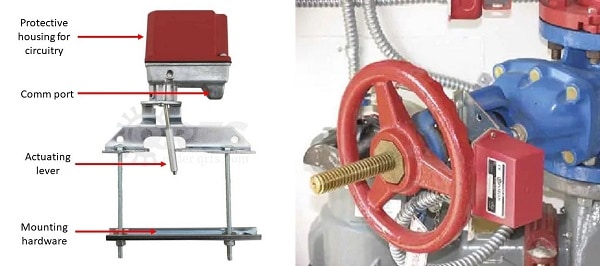
Many valves sold as dedicated fire sprinkler system control valves come with built-in tamper switches, saving the trouble of installation. However, other butterfly valves and OS&Y valves can serve as control valves and be fitted with the necessary tamper switches as long as they are listed for the purpose.
Depending on the type of system, a tamper switch’s signal can be sent to various locations. Ideally, it transmits to a dedicated and centralized monitoring station attended by on-site, in-house staff or a remote fire alarm and security monitoring service. The NFPA 13 Handbook explains that monitoring by a central station is “preferred over the other methods” because such outfits can quickly pass along trouble signals to building management or the fire department.
However, NFPA 13 acknowledges that central monitoring can be impractical “due to the cost of such a system.” Thus, the standard offers the alternative of an audible alarm generated at a “constantly attended” point in the building.
Some switches sound fire alarms when sprinklers activate
Water flow and pressure switches monitor a fire sprinkler system to determine its activation state, essentially detecting flowing water or a drop in pressure to determine if sprinklers have operated. When a sprinkler head goes off, the switch gives a signal to generate an alarm. Both flow switches and pressure switches can be used to detect sprinkler operation, with flow switches employed in most systems.
Flow switches operate based on a very simple mechanism. A small paddle tees into a fire sprinkler riser pipe—while the water remains stationary, the paddle remains still. But when a sprinkler head opens and water flows, the force of the moving water pushes the paddle, closing an electric circuit and generating a signal.
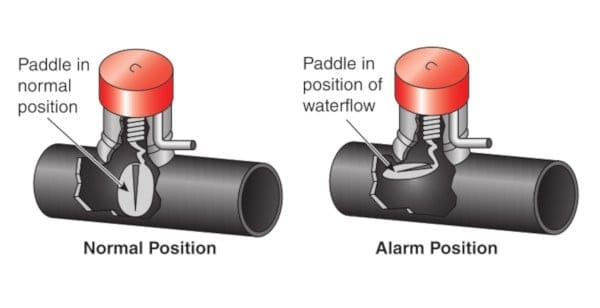
Most wet-pipe fire sprinkler systems require water flow detection devices, normally in the form of flow switches. Dry pipe systems cannot have paddle-type flow switches, however (16.11.3.4). This is because when a dry sprinkler system discharges, the sudden rush of water could easily break off the paddle and obstruct the pipe downstream.
The basic NFPA 13 rules for these switches are as follows:
- All waterflow and pressure switches must be listed for the purpose (A.7.1.1)
- If the sprinkler system has more than 20 heads, there must be a local waterflow alarm that activates alarm bells or other audiovisual devices (16.11.2.1)
- Per the NFPA 13 Handbook, switches in low-rise settings need not signal a fire alarm control panel
In high-rise buildings, waterflow detection plays a very important role and has extra requirements (16.11.10). Namely, sprinkler systems in high-rises must have flow switches on every floor. These switches must initiate alarms, and each one must signal to a fire alarm control panel. Such a setup helps sound the alarm in the event of a fire and directs firefighters to the right floor.
Electronic supervisory switches alert you to problems with your fire sprinkler system
Fire sprinklers guard lives and property—but only if the water is accessible. A class of electronic monitoring equipment, supervisory switches provide information about the state and functionality of the sprinkler system.
There is no real difference between a supervisory switch and a tamper switch—because a tamper switch is a supervisory switch. These devices send a trouble signal whenever a fire sprinkler control valve is closed. This prevents fire sprinkler systems from being inactivated, intentionally or not, without the knowledge of building management.
Waterflow switches are another common type of supervisory switch that sounds the alarm when a fire sprinkler system activates by detecting either the flow of water or an internal drop in water pressure. In high-rise buildings, flow switches serve the dual purpose of alerting occupants to danger and helping firefighters get to the scene faster.
To get situational awareness for your fire sprinkler system, shop QRFS’s selection of add-on tamper switches, butterfly valves prewired with tamper switches, water pressure switches, and water flow switches:
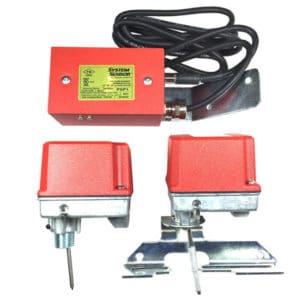
Add-on tamper switches |
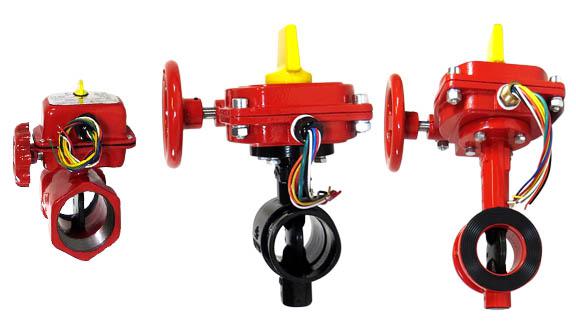 Butterfly valves with tamper switches Butterfly valves with tamper switches
|

Water Pressure Switches |
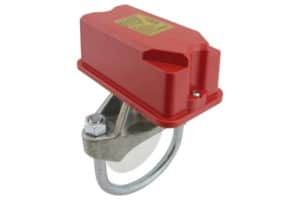
Water Flow Switches 1 in. to 1 1/2 in. | 2 in. | 2 1/2 in. | 3 in. | 4 in. |5 in. |6 in. |8 in. |
|---|
If you have questions or need help placing an order, call us at 888.361.6662 or email support@qrfs.com.
This blog was originally posted at blog.qrfs.com. If this article helped you, check us out at Facebook.com/QuickResponseFireSupply or on Twitter @QuickResponseFS.


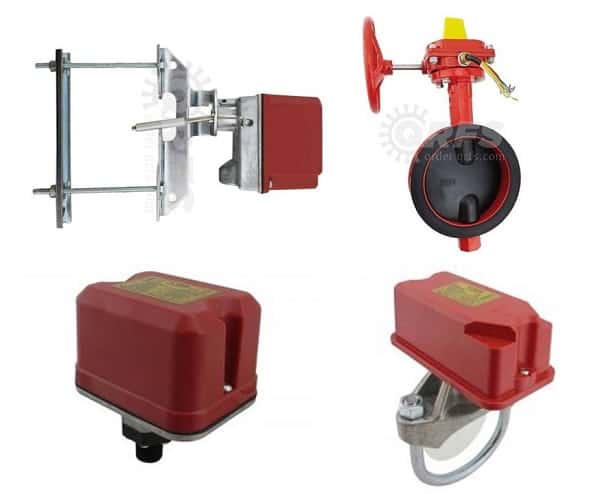
Is “supervisory signal initiating device” the same as “supervisory switch”?
Basically!
Supervisory switch how to connect butterfly valve , please show me some picture or methodology
Periyasamy — We don’t have those materials created, but there should be at least a simple installation diagram on the data sheet for these switches, such as this one from SafeSignal. Contacting the manufacturer of the supervisory switch in question or reviewing their materials is your best resource. Thanks for reading!
The panel shows Supervisory Main Riser Bottom. Is this an alert that the water flow has been shut down?
Al — It may depend on how the system is programmed (electronic supervision signals tend to be ‘dumb’), whether there is a control panel malfunction, and the specific device sending a signal (a supervised control valve indicates the valve is closed), but quite possibly yes, it may indicate the valve at the main riser is shut off. You should contact an alarm/sprinkler pro to evaluate the situation and remedy it ASAP. (Presumably, you’d know if a sprinkler activated somewhere or you had a major leak, so it’s likely not a flow switch!)